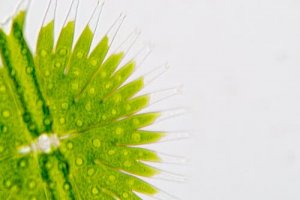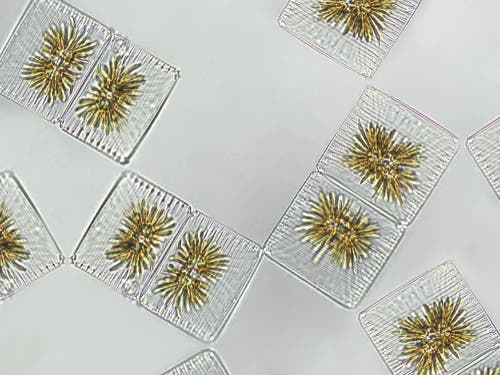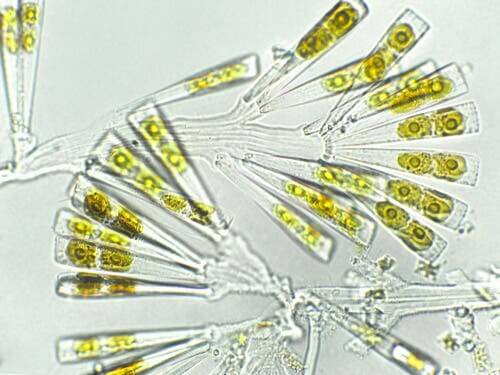Phytoplankton for Dogs: What Is It?


Written and verified by biochemistry Luz Eduviges Thomas-Romero
Among superfoods for pets, experts have been considering whether phytoplankton for dogs is a good option. These microscopic organisms provide a high content of fatty acids, minerals, antioxidants, amino acids, and vitamins.
Now, animal experts are including phytoplankton for dogs on must-have food lists due to its many nutritional benefits. However, before including this supplement in your pet’s diet, you should investigate thoroughly. You should also discuss feeding your dog this food with your vet. That way, you can avoid any issues that your dog may have with phytoplankton.
What should you know about phytoplankton for dogs?
Phytoplankton is made up of two types of single-celled microscopic organisms: microalgae and cyanobacteria. Millions of these organisms live floating on the layers of the sea and bodies of freshwater all over the planet. In some bodies of water, 90 percent of the biomass is made up of phytoplankton.
In fact, these organisms were the first living things with the ability to conduct photosynthesis. As you may know, photosynthesis produces oxygen. This production of oxygen and reduction of carbon dioxide is what allowed for the emergence of higher life forms.
For ecologists, phytoplankton represents the first link in an aquatic food chain. This is because they’re primary producers. Scientists classify the species that make up phytoplankton as autotrophs. This name comes from the ability to live and reproduce solely from photosynthesis – producing organic substances from inorganic substances.
However, experts consider these microorganisms a superfood because of a high content of fatty acids, minerals, antioxidants, amino acids, and vitamins.

What species make up phytoplankton?
It’s interesting to note that phytoplankton is extremely diverse. In fact, this group is made up of thousands of different species. This high level of diversity allows phytoplankton to adapt to the conditions of the waters they inhabit.
As a result, there are different factors that can affect the prevalence of certain species of phytoplankton. These factors include salinity level, temperature, how transparent the water is, and nutrient content.
Experts have mostly studied phytoplankton groups such as diatoms, dinoflagellates, cyanophytes or blue-green algae, brown algae, and coccolithophorids. Then, thousands of species make up each group.
What are the benefits of phytoplankton for dogs?
The benefits of phytoplankton for dogs are associated with the high content of the following nutrients:
1. Long chain fatty acids: Omega-3 and omega-6
Similar to the effect in humans, omega-3 and omega-6 influence several bodily processes of dogs. Experts recommend them for treating skin conditions, allergies, kidney function, heart disease, cognitive function, and arthritis, just to name a few examples.
Also, it’s interesting that there are three main omega-3s: eicosapentaenoic acids (EPA), docosahexaenoic acid (DHA), and alpha-linolenic acid (ALA). You should be aware that freshwater phytoplankton doesn’t produce EPA.

2. Phytoplankton for dogs provides essential minerals
Dogs tend to be deficient in many trace minerals. However, some of these minerals are critical to basic biological functions. Phytoplankton is a great source of some of these minerals, such as selenium, magnesium, and iodine. These can aid in digestion and hormonal regulation, as well as benefiting joint issues and thyroid health.
However, you should be aware that these microorganisms can contain toxic heavy metals, depending on where it’s harvested. As a result, you should be careful to only purchase high-quality phytoplankton.
3. A good supply of antioxidants
Antioxidants are substances that inhibit oxidation. If oxidation occurs in excess, it can be harmful to living beings. As a result, phytoplankton is great for its antioxidant content. This can help prevent or reduce cell damage in your dog’s body. Oxidative damage is common in diseases like cancer, heart disease, and autoimmune disorders.
A valid dietary supplement
Even in small doses, experts have found that phytoplankton improves health. It has beneficial effects on joint mobility, allergies, and skin disorders. Additionally, some vets recommend it to help treat chronic diseases. However, this doesn’t mean that it can cure disorders on its own. A vet may recommend it in conjunction with other medications.
In conclusion, phytoplankton for dogs is not a superfood. However, it can be a good supplement (if your vet approves!).
Among superfoods for pets, experts have been considering whether phytoplankton for dogs is a good option. These microscopic organisms provide a high content of fatty acids, minerals, antioxidants, amino acids, and vitamins.
Now, animal experts are including phytoplankton for dogs on must-have food lists due to its many nutritional benefits. However, before including this supplement in your pet’s diet, you should investigate thoroughly. You should also discuss feeding your dog this food with your vet. That way, you can avoid any issues that your dog may have with phytoplankton.
What should you know about phytoplankton for dogs?
Phytoplankton is made up of two types of single-celled microscopic organisms: microalgae and cyanobacteria. Millions of these organisms live floating on the layers of the sea and bodies of freshwater all over the planet. In some bodies of water, 90 percent of the biomass is made up of phytoplankton.
In fact, these organisms were the first living things with the ability to conduct photosynthesis. As you may know, photosynthesis produces oxygen. This production of oxygen and reduction of carbon dioxide is what allowed for the emergence of higher life forms.
For ecologists, phytoplankton represents the first link in an aquatic food chain. This is because they’re primary producers. Scientists classify the species that make up phytoplankton as autotrophs. This name comes from the ability to live and reproduce solely from photosynthesis – producing organic substances from inorganic substances.
However, experts consider these microorganisms a superfood because of a high content of fatty acids, minerals, antioxidants, amino acids, and vitamins.

What species make up phytoplankton?
It’s interesting to note that phytoplankton is extremely diverse. In fact, this group is made up of thousands of different species. This high level of diversity allows phytoplankton to adapt to the conditions of the waters they inhabit.
As a result, there are different factors that can affect the prevalence of certain species of phytoplankton. These factors include salinity level, temperature, how transparent the water is, and nutrient content.
Experts have mostly studied phytoplankton groups such as diatoms, dinoflagellates, cyanophytes or blue-green algae, brown algae, and coccolithophorids. Then, thousands of species make up each group.
What are the benefits of phytoplankton for dogs?
The benefits of phytoplankton for dogs are associated with the high content of the following nutrients:
1. Long chain fatty acids: Omega-3 and omega-6
Similar to the effect in humans, omega-3 and omega-6 influence several bodily processes of dogs. Experts recommend them for treating skin conditions, allergies, kidney function, heart disease, cognitive function, and arthritis, just to name a few examples.
Also, it’s interesting that there are three main omega-3s: eicosapentaenoic acids (EPA), docosahexaenoic acid (DHA), and alpha-linolenic acid (ALA). You should be aware that freshwater phytoplankton doesn’t produce EPA.

2. Phytoplankton for dogs provides essential minerals
Dogs tend to be deficient in many trace minerals. However, some of these minerals are critical to basic biological functions. Phytoplankton is a great source of some of these minerals, such as selenium, magnesium, and iodine. These can aid in digestion and hormonal regulation, as well as benefiting joint issues and thyroid health.
However, you should be aware that these microorganisms can contain toxic heavy metals, depending on where it’s harvested. As a result, you should be careful to only purchase high-quality phytoplankton.
3. A good supply of antioxidants
Antioxidants are substances that inhibit oxidation. If oxidation occurs in excess, it can be harmful to living beings. As a result, phytoplankton is great for its antioxidant content. This can help prevent or reduce cell damage in your dog’s body. Oxidative damage is common in diseases like cancer, heart disease, and autoimmune disorders.
A valid dietary supplement
Even in small doses, experts have found that phytoplankton improves health. It has beneficial effects on joint mobility, allergies, and skin disorders. Additionally, some vets recommend it to help treat chronic diseases. However, this doesn’t mean that it can cure disorders on its own. A vet may recommend it in conjunction with other medications.
In conclusion, phytoplankton for dogs is not a superfood. However, it can be a good supplement (if your vet approves!).
All cited sources were thoroughly reviewed by our team to ensure their quality, reliability, currency, and validity. The bibliography of this article was considered reliable and of academic or scientific accuracy.
- Chrétiennot-Dinet, M. J., Sournia, A., Ricard, M., & Billard, C. (1993). A classification of the marine phytoplankton of the world from class to genus. Phycologia, 32(3), 159-179.
- Delgado, M., & Fortuño Alós, J. M. (1991). Atlas de fitoplancton del Mar Mediterráneo. Scientia Marina 55(S1): 1-133
- Tapia, J., Basualto, S., & Urrutia, R. (1996). Contenido de metales pesados en microalgas y su agua circundante. CIT Ediciones Tecnologicas, 17-21.
- Pelegrin, Y. (2001). Algas en la “botica”. Departamento de recursos del mar de la Unidad de Mérida del Cinvestav. Rev. Avance y Perspectiva, 20.
- Lenox, C. E. (2016). Role of dietary fatty acids in dogs & cats. Today’s Veterinary Practice Journal: ACVN Nutrition Notes, 6(5), 83-90.
This text is provided for informational purposes only and does not replace consultation with a professional. If in doubt, consult your specialist.








